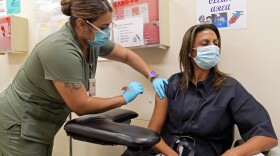Most people tested for COVID-19 have had to endure an extra-long swab inserted into a nostril and snaked through the nasal cavity until it touches the back of the throat.
This process, called a nasopharyngeal swab, isn't just uncomfortable for the patient. It often induces sneezing and coughing, putting health care workers at risk of infection and making them use up valuable protective gear.
Early on in the outbreak, staff at a local medical clinic realized this method was burning through their supply of personal protective equipment, or PPE.
"It became very apparent that we did not have enough PPE for the long run," said Dr. Yuan-Po Tu, who works at the Everett Clinic, a group of 30 medical offices in Snohomish and King counties.
Tu had spent decades studying the flu. But working in the Everett area, where the country's first novel coronavirus case was diagnosed, he and his colleagues were on the front lines of a new outbreak, trying to detect the virus in their patients.
Tu said, after a meeting on the clinic’s dwindling supply of protective gear, he went home and thought: "The only way we can change this is change the way we test people for COVID."
That night, the doctor said, he wrote a proposal for an experiment exploring a simpler way to test for COVID-19. By the next morning, he said, the plan was in motion.
The question Tu wanted to answer: Could a COVID-19 test be simple, safe, and painless enough that patients could swab themselves?
"If we could do that, we could save a lot of PPE," he said.

The Everett Clinic's parent company, UnitedHealth Group, signed off on the experiment. The clinic said it found partners at the University of Washington, the Bill and Melinda Gates Foundation, and the laboratory Quest Diagnostics.
Researchers designed a new method of testing. Patients used Q-tip-sized swabs to probe their own noses.
They swabbed one nostril, then the other, without going nearly as deep as the old method required.
Health care providers could stand across the room and observe without donning as much protective equipment.
After a study of 450 patients, the results were promising.
"The samples were just as accurate in making the diagnosis of COVID as if a nurse or a medical assistant obtained the sample using a nasopharyngeal swab," Tu said.
"This is much more user-friendly,” he added. “It causes much less sneezing and coughing and is much more comfortable. And it also is much quicker."
Shortly after the experiment ended, researchers showed their findings to officials at the Food and Drug Administration on a Sunday night in March, Tu said.
The agency updated its national testing guidelines on March 23 to say, "for symptomatic patients, nasal swabs could be used that access just the front of the nose rather than the depth of the nasal cavity."
"This would provide COVID-19 testing that is more comfortable for patients, allows self-collection of specimens at collection sites, and that can be performed with a simpler and more readily available swab," FDA officials wrote.
The FDA's guidelines say that, while a nasopharyngeal swab is "preferred," the self-swabbing method in the front of the nose is "acceptable."
It's the method the Everett Clinic now uses to test many of its patients, Tu said.
He said he's also presented the study's findings to public health officials elsewhere in Washington state, and it's catching on in some other areas of the country where UnitedHealth Group operates.
Tu has moved on to new problems. Public health officials have said in order to start relaxing social-distancing rules, they need the ability to quickly test large numbers of people. But a shortage of specialized swabs is one factor limiting the number of tests that can be performed in the United States.
Tu said he's helping experiment with different swab materials that are more plentiful, and could help alleviate the shortage if they prove to work.







